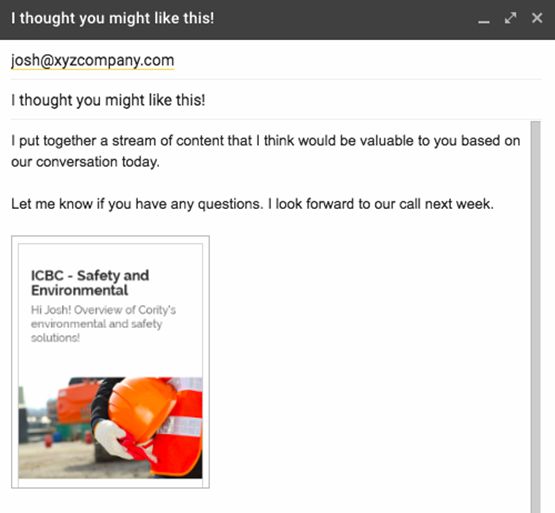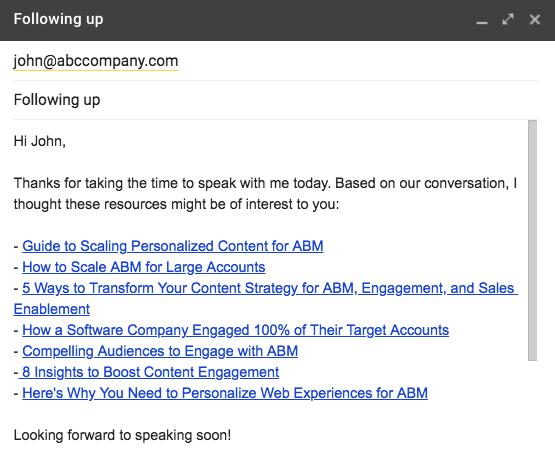Why do we trust Google as a search engine as much as we do? Besides the fun and engaging doodles, Google consistently delivers the search results we need on the first try, which means we don’t have to waste time searching through other options. We trust it so much that when we ask Siri or Alexa for help, we’ll roll with the answer they provide—the top Google search result—without a second thought.
More than ever, brands are facing pressure to deliver that same level of customization to customers. You earn their trust and maintain it when you do what Google is so adept at: deliver relevant, personalized content to your customers in a timely manner.
Delivering personalized content at scale is not easy, though. It requires a strategic effort to create content experiences that help you win across various types of marketing strategy, including inbound, demand generation, account-based marketing, and sales enablement.
Let’s look at some best-practices for delivering personalized content using each of those four strategies, along with examples of companies that have mastered each approach.
Strategy 1: Inbound
With inbound marketing, content is just as critical for success as being discovered through search. Simply put, if prospects don’t find content that fits their needs when they land on your site, they’ll click away and look elsewhere. And if they do stick around, your job is to keep them engaging with one piece of content after another.
An effective way to do that is to include calls to action (CTAs) in the content you’ve provided. If they find your content valuable, and they can receive more of it with almost no effort, they’ll be much more likely to take the action you’re requesting.
For example, Trimble includes the CTA “Sign Up to Get Tips & Articles Sent Directly To Your Inbox!” alongside its content assets. Notice that this CTA makes sense within the context of what the customer is consuming. It wouldn’t make sense for that CTA to appear on a page that’s strictly videos.
When inbound marketing is done right, prospects effortlessly move from one content asset to the next, and each asset is relevant to their needs. When your company provides that kind of experience, it’s easier to convert someone into a lead.
Strategy 2: Demand Generation
Demand generation is focused on increasing awareness and interest in a company’s products or services once someone has shown interest. It’s about driving the lead into the pipeline so they interact with more content and eventually make a purchase. So, how do you deliver a content experience that propels prospects to self-nurture?
If the goal is to get leads to consume multiple pieces of content, it’s probably not best to build out multiple landing pages or blog posts. Chasing the next piece of content across multiple destinations is not an ideal content experience. Instead, you should consider housing all of your content assets in one place. Wistia provides a great example with its One, Ten, One Hundred series.
Wistia’s emails send people to a collection of content that includes a series description, trailer, and access to every video on one page if they want to binge-watch. Everything is designed to let leads know what to expect and go at their own pace.
Strategy 3: Account-Based Marketing
ABM involves developing a targeted approach to landing accounts that your company has identified as important. In the early days of ABM, marketers spent more time selecting desirable accounts than they did deciding how to engage those accounts with content. Today, marketers are more strategic about using personalized content to engage with target buyers and develop that relationship.
That’s the key: continuing to deliver personalized content that furthers the relationship. You need a varied approach to avoid becoming stale and losing the buyer’s interest.
One company that’s done very well with ABM is TouchBistro, a point-of-sale (POS) solution that’s built out marketing streams for different types of food vendors.
Its “Restaurant Success Library” has customized content for full-service restaurants, fast-casual places, bars, food trucks, breweries, and coffee shops. For example, breweries are greeted by the message, “Inspire and grow your brewery with these custom articles” and a vast, customized resource library that appears like it was tailor-made for them.
When you can drop an account into a customized content stream that continues to deliver an amazing experience, it goes a long way toward success with ABM.
Strategy 4: Sales Enablement
As any good marketer knows, one of your primary jobs is enabling the sales team to sell. That means communicating with sales about what type of content is in the works and pointing them toward existing assets they can use.
With relevant content assets in hand, sales won’t drown buyers in the black-and-blue ocean. You know what I’m talking about: those emails with so much blue, hyperlinked text that it looks like a bad bruise. That’s the opposite of a good content experience.
Cority, which provides software for environmental health and safety companies, avoids the black-and-blue ocean by sending a short, personalized email that links to a curated collection of content.

Would you rather see that email in your inbox, or one like this?

Statistics tell us that the first approach is far more successful: Personalizing the content makes customers 40% more likely to buy from you than from a competitor that takes a one-size-fits all approach.
If you want to personalize at scale, enable your sales team to make it happen.
Focus on the Content Experience
No matter your strategy, don’t lose sight of how important the experience is when delivering personalized content. Content is capable of engaging all types of customers—new, renewing, or at-risk—but the journey they take (the content experience) will determine whether they continue forward or go elsewhere for what they need.
All four marketing strategies encompass the content experience, so no company can say they don’t have a content experience. You do, and the question is, Are you winning or losing deals with yours?
